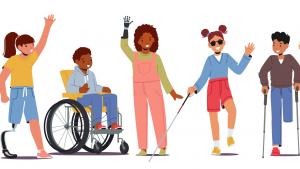There are many life transitions which are unique to children, like starting school, moving from primary to secondary school, and entering adulthood. For some disabled children, transitions may be distinct from and occur at different times to most children.
This may include moving from mainstream to specialist services; from living with their family to residential educational settings; from children’s health and social care services to adult ones; and for some young people, it may be transitioning to living independently. Care-experienced disabled children and young people often experience additional transitions, such as care placement moves which can result in knock-on changes to schooling and the area they live.
When these transitions do not involve meaningful consultation with children, are not effectively planned for, or are not properly supported, they can be disruptive and traumatic for the child or young person. While some disabled children I have spoken with report very positive experiences of transitioning between services and support, for others it can be overwhelming and destabilising. The variation in children’s experiences is sometimes exacerbated by the postcode lottery of effective support for transitions.
Sharp cliff-edges in support, particularly around the transition from children’s to adult’s services, is something children experience across a range of services. Professionals at a residential special school my team visited spoke about one young person they had been supporting who recently turned 18.
This young person had been using pull up pads to date, which they found suited them and enabled them to go to the bathroom on their own. However, under adult services, only wrap around pads were being given to this young person. The staff felt the young person’s independence was taken away, as they were now no longer able to go to the bathroom on their own.
Even before a child turns 18, professionals speak about a ‘16 to 18 void’ in the NHS which many of the children they support experience – falling between the gaps of children’s and adult’s services. For example, some 16- and 17-year-olds are placed in adult hospital and mental health wards, which is not always appropriate. Professionals also reflected that sometimes neither children’s nor adult’s services want to pay for products that are essential to the young people, even those which have been prescribed.
Furthermore, young disabled people talk about the difficulty of knowing which services will support them when they move between different local authorities, for example which local authority is responsible for their care plan and EHCP, and which NHS trust they can access.
At such a critical time in their lives, disabled children want their health, education and care needs to be understood and responded to in a joined-up way, without arbitrary cliff-edges in support. We must take a much more holistic approach to every child, and break down the system siloes that split children between services, models of care, and thresholds for support – and reduce accountability.
I believe that a consistent child identifier is central to this mission. To know more, please see my blog Connecting the dots – the importance of sharing data on children and families





